Cisco Nexus 93108TC-FX Service Manual

Cisco Nexus 93108TC-FX ACI Mode Hardware Installation Guide
First Published: 2017-04-11
Last Modified: 2017-10-05
Americas Headquarters
Cisco Systems, Inc. 170 West Tasman Drive
San Jose, CA 95134-1706 USA http://www.cisco.com Tel: 408 526-4000
800 553-NETS (6387) Fax: 408 527-0883
THE SPECIFICATIONS AND INFORMATION REGARDING THE PRODUCTS IN THIS MANUAL ARE SUBJECT TO CHANGE WITHOUT NOTICE. ALL STATEMENTS, INFORMATION, AND RECOMMENDATIONS IN THIS MANUAL ARE BELIEVED TO BE ACCURATE BUT ARE PRESENTED WITHOUT WARRANTY OF ANY KIND, EXPRESS OR IMPLIED. USERS MUST TAKE FULL RESPONSIBILITY FOR THEIR APPLICATION OF ANY PRODUCTS.
THE SOFTWARE LICENSE AND LIMITED WARRANTY FOR THE ACCOMPANYING PRODUCT ARE SET FORTH IN THE INFORMATION PACKET THAT SHIPPED WITH THE PRODUCT AND ARE INCORPORATED HEREIN BY THIS REFERENCE. IF YOU ARE UNABLE TO LOCATE THE SOFTWARE LICENSE OR LIMITED WARRANTY, CONTACT YOUR CISCO REPRESENTATIVE FOR A COPY.
The following information is for FCC compliance of Class A devices: This equipment has been tested and found to comply with the limits for a Class A digital device, pursuant to part 15 of the FCC rules. These limits are designed to provide reasonable protection against harmful interference when the equipment is operated in a commercial environment. This equipment generates, uses, and can radiate radio-frequency energy and, if not installed and used in accordance with the instruction manual, may cause harmful interference to radio communications. Operation of this equipment in a residential area is likely to cause harmful interference, in which case users will be required to correct the interference at their own expense.
The following information is for FCC compliance of Class B devices: This equipment has been tested and found to comply with the limits for a Class B digital device, pursuant to part 15 of the FCC rules. These limits are designed to provide reasonable protection against harmful interference in a residential installation. This equipment generates, uses and can radiate radio frequencyenergyand,ifnotinstalledandusedinaccordancewiththeinstructions,maycauseharmfulinterferencetoradiocommunications. However,thereisnoguaranteethatinterference will not occur in a particular installation. If the equipment causes interference to radio or television reception, which can be determined by turning the equipment off and on, users are encouraged to try to correct the interference by using one or more of the following measures:
•
•
•
•
Reorient or relocate the receiving antenna.
Increase the separation between the equipment and receiver.
Connect the equipment into an outlet on a circuit different from that to which the receiver is connected.
Consult the dealer or an experienced radio/TV technician for help.
Modifications to this product not authorized by Cisco could void the FCC approval and negate your authority to operate the product
The Cisco implementation of TCP header compression is an adaptation of a program developed by the University of California, Berkeley (UCB) as part of UCB’s public domain version of the UNIX operating system. All rights reserved. Copyright © 1981, Regents of the University of California.
NOTWITHSTANDINGANYOTHERWARRANTYHEREIN,ALLDOCUMENTFILESANDSOFTWAREOFTHESESUPPLIERSAREPROVIDED"ASIS"WITHALLFAULTS. CISCO AND THE ABOVE-NAMED SUPPLIERS DISCLAIM ALL WARRANTIES, EXPRESSED OR IMPLIED, INCLUDING, WITHOUT LIMITATION, THOSE OF MERCHANTABILITY,FITNESSFORAPARTICULARPURPOSEANDNONINFRINGEMENTORARISINGFROMACOURSEOFDEALING,USAGE,ORTRADEPRACTICE.
IN NO EVENT SHALL CISCO OR ITS SUPPLIERS BE LIABLE FOR ANY INDIRECT, SPECIAL, CONSEQUENTIAL, OR INCIDENTAL DAMAGES, INCLUDING, WITHOUT LIMITATION, LOST PROFITS OR LOSS OR DAMAGE TO DATA ARISING OUT OF THE USE OR INABILITY TO USE THIS MANUAL, EVEN IF CISCO OR ITS SUPPLIERS HAVE BEEN ADVISED OF THE POSSIBILITY OF SUCH DAMAGES.
AnyInternetProtocol(IP)addressesandphonenumbersusedinthisdocumentarenotintendedtobeactualaddressesandphonenumbers. Anyexamples,commanddisplayoutput,network topologydiagrams,andotherfiguresincludedinthedocumentareshownforillustrativepurposesonly. AnyuseofactualIPaddressesorphonenumbersinillustrativecontentisunintentional and coincidental.
Cisco and the Cisco logo are trademarks or registered trademarks of Cisco and/or its affiliates in the U.S. and other countries. To view a list of Cisco trademarks, go to this URL: https:/ /www.cisco.com/go/trademarks. Third-party trademarks mentioned are the property of their respective owners. The use of the word partner does not imply a partnership relationship between Cisco and any other company. (1721R)
© 2017 Cisco Systems, Inc. All rights reserved.

C O N T E N T S
P r e f a c e |
|
Preface vii |
|
|
|
|
Audience vii |
|
|
|
|
Documentation Conventions vii |
|
|
|
|
Related Documentation viii |
|
|
|
|
Documentation Feedback |
x |
|
|
|
Obtaining Documentation and Submitting a Service Request x |
||
|
|
Overview 1 |
|
|
C H A P T E R |
1 |
|
|
|
|
|
Overview 1 |
|
|
|
|
Preparing the Site 5 |
|
|
C H A P T E R |
2 |
|
|
|
|
|
Temperature Requirements 5 |
|
|
|
|
Humidity Requirements |
5 |
|
|
|
Altitude Requirements 6 |
|
|
|
|
Dust and Particulate Requirements |
6 |
|
|
|
Minimizing Electromagnetic and Radio Frequency Interference 6 |
||
|
|
Shock and Vibration Requirements |
7 |
|
|
|
Grounding Requirements |
7 |
|
|
|
Planning for Power Requirements |
7 |
|
|
|
Airflow Requirements 9 |
|
|
|
|
Rack and Cabinet Requirements 9 |
|
|
|
|
Clearance Requirements |
10 |
|
|
|
Installing the Switch Chassis |
13 |
|
C H A P T E R |
3 |
|
||
|
|
Safety 13 |
|
|
Installation Options with Racks and Cabinets 14
Airflow Considerations 14
Cisco Nexus 93108TC-FX ACI Mode Hardware Installation Guide
iii
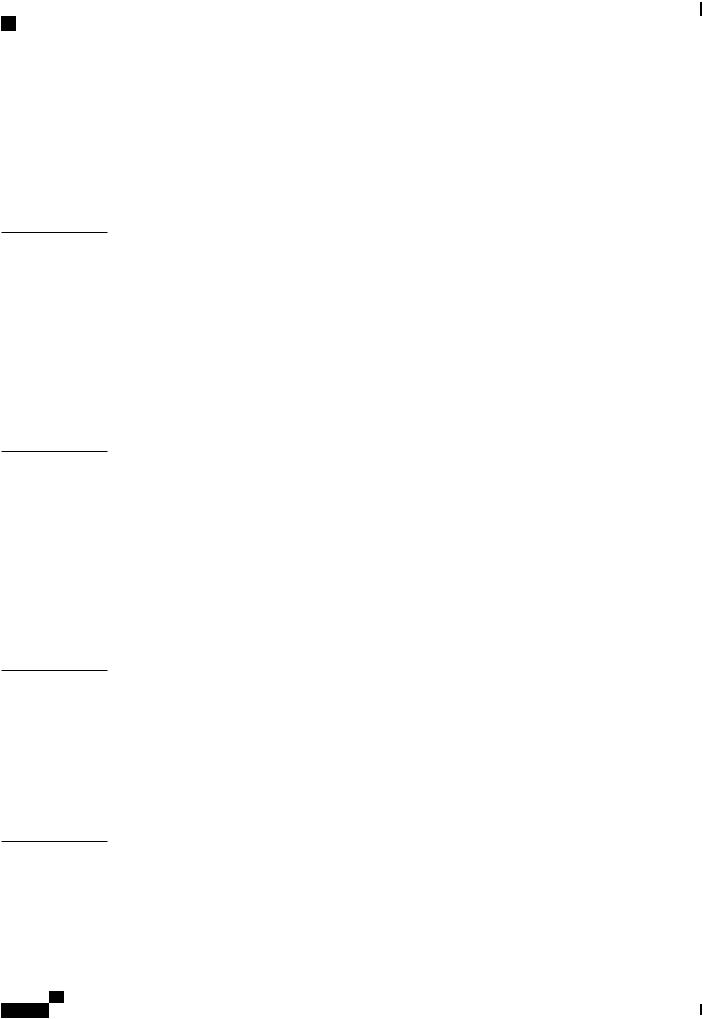
Contents
Installation Guidelines 14
Unpacking and Inspecting the Switch 15
Installing the Switch 16
Grounding the Chassis 20
Starting the Switch 22
C H A P T E R 4
C H A P T E R 5
A P P E N D I X A
A P P E N D I X B
Connecting the Switch to the ACI Fabric 25
ACI Fabric Topology 25
Preparing to Connect to Other Devices 26
Connecting Leaf Switches to APICs 27
Connecting Leaf Switches to Spine Switches 28
Setting Up an Optional Console Interface 31
Setting Up an Optional Management Connection 32
Maintaining Transceivers and Optical Cables 32
Replacing Components 35
Replacing a Fan Module 35
Removing a Fan Module 36
Installing a Fan Module 36
Replacing a Power Supply Module 36
Replacing an AC Power Supply 37
Replacing a High Voltage (HVAC/HVDC) Power Supply 38
Replacing a DC Power Supply 39
Rack Specifications 43
Overview of Racks 43
General Requirements for Cabinets and Racks 43
Requirements Specific to Standard Open Racks 44
Requirements Specific to Perforated Cabinets 44
Cable Management Guidelines 44
System Specifications 45
Environmental Specifications 45
Switch Dimensions 45
Switch and Module Weights and Quantities 46
Cisco Nexus 93108TC-FX ACI Mode Hardware Installation Guide
iv

Contents
A P P E N D I X C
A P P E N D I X D
A P P E N D I X E
Transceiver and Cable Specifications 46
Switch Power Input Requirements 46
Power Specifications 47
500-W AC Power Supply Specifications 47
1200-W HVAC/HVDC Power Supply Specifications 48
930-W DC Power Supply Specifications 48
Power Cable Specifications 49
Power Cable Specifications for AC Power Supplies 49
HVAC/HVDC Power Cables Supported by ACI-Mode and NX-OS Mode Switches 50
DC Power Cable Specifications 51
Regulatory Standards Compliance Specifications 51
LEDs 53
Switch Chassis LEDs 53
Fan Module LEDs 54
Power Supply LEDs 54
Additional Kits 57
Accessory Kit 57
Site Preparation and Maintenance Records 59
Site Preparation Checklist 59
Contact and Site Information 61
Chassis and Module Information 61
Cisco Nexus 93108TC-FX ACI Mode Hardware Installation Guide
v

Contents
Cisco Nexus 93108TC-FX ACI Mode Hardware Installation Guide
vi
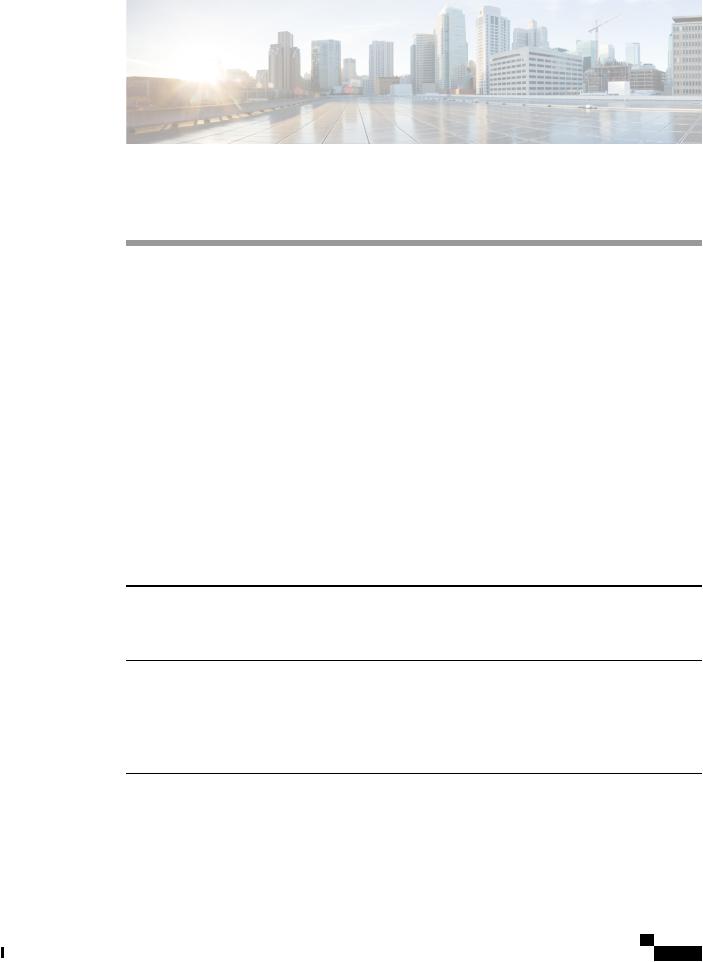
Preface
• Audience, page vii
• Documentation Conventions, page vii
• Related Documentation, page viii
• Documentation Feedback, page x
• Obtaining Documentation and Submitting a Service Request, page x
Audience
This publication is for hardware installers and network administrators who install, configure, and maintain Cisco Nexus switches.
Documentation Conventions
Command descriptions use the following conventions:
Convention |
Description |
bold |
Bold text indicates the commands and keywords that you enter literally |
|
as shown. |
Italic |
Italic text indicates arguments for which the user supplies the values. |
[x] |
Square brackets enclose an optional element (keyword or argument). |
[x | y] |
Squarebracketsenclosingkeywordsorargumentsseparatedbyavertical |
|
bar indicate an optional choice. |
{x | y} |
Braces enclosing keywords or arguments separated by a vertical bar |
|
indicate a required choice. |
Cisco Nexus 93108TC-FX ACI Mode Hardware Installation Guide
vii

Preface
Related Documentation
Convention |
Description |
[x {y | z}] |
Nested set of square brackets or braces indicate optional or required |
|
choices within optional or required elements. Braces and a vertical bar |
|
within square brackets indicate a required choice within an optional |
|
element. |
variable |
Indicatesavariableforwhichyousupplyvalues,incontextwhereitalics |
|
cannot be used. |
string |
A nonquoted set of characters. Do not use quotation marks around the |
|
string or the string will include the quotation marks. |
Examples use the following conventions: |
|
Convention |
Description |
screen font |
Terminalsessionsandinformationtheswitchdisplaysareinscreenfont. |
boldface screen font |
Information you must enter is in boldface screen font. |
italic screen font |
Arguments for which you supply values are in italic screen font. |
< > |
Nonprinting characters, such as passwords, are in angle brackets. |
[ ] |
Default responses to system prompts are in square brackets. |
!, # |
An exclamation point (!) or a pound sign (#) at the beginning of a line |
|
of code indicates a comment line. |
Related Documentation
TheApplicationCentricInfrastructuredocumentationsetincludesthefollowingdocumentsthatareavailable on Cisco.com at the following URL: https://www.cisco.com/c/en/us/support/cloud-systems-management/ application-policy-infrastructure-controller-apic/tsd-products-support-series-home.html.
Web-Based Documentation
•Cisco APIC Management Information Mode Reference
•Cisco APIC Online Help Reference
•Cisco APIC Python SDK Reference
•Cisco ACI Compatibility Tool
•Cisco ACI MIB Support List
Cisco Nexus 93108TC-FX ACI Mode Hardware Installation Guide
viii

Preface
Related Documentation
Downloadable Documentation
•Knowledge Base Articles (KB Articles)are available at the following URL: https://www.cisco.com/c/ en/us/support/cloud-systems-management/application-policy-infrastructure-controller-apic/ products-configuration-examples-list.html
•Cisco Application Centric Infrastructure Controller Release Notes
•Cisco Application Centric Infrastructure Fundamentals Guide
•Cisco APIC Getting Started Guide
•Cisco ACI Virtualization Guide
•Cisco APIC REST API User Guide
•Cisco APIC Command Line Interface User Guide
•Cisco APIC Faults, Events, and System Messages Management Guide
•Cisco ACI System Messages Reference Guide
•Cisco APIC Layer 4 to Layer 7 Services Deployment Guide
•Cisco APIC Layer 4 to Layer 7 Device Package Development Guide
•Cisco APIC Layer 4 to Layer 7 Device Package Test Guide
•Cisco ACI Firmware Management Guide
•Cisco ACI Troubleshooting Guide
•Cisco ACI Switch Command Reference, NX-OS Release 11.0
•Cisco Verified Scalability Guide for Cisco ACI
•Cisco ACI MIB Quick Reference
•Cisco Nexus CLI to Cisco APIC Mapping Guide
•Application Centric Inftrastructure Fabric Hardware Installation Guide
•Cisco NX-OS Release Notes for Cisco Nexus 9000 Series ACI-Mode Switches
•Cisco Nexus 9000 Series ACI Mode Licensing Guide
•Cisco Nexus 93108TX-EX ACI-Mode Switch Hardware Installation Guide
•Cisco Nexus 93108TX-FX ACI-Mode Switch Hardware Installation Guide
•Cisco Nexus 93120TX ACI-Mode Switch Hardware Installation Guide
•Cisco Nexus 93128TX ACI-Mode Switch Hardware Installation Guide
•Cisco Nexus 93180LC-EX ACI-Mode Switch Hardware Installation Guide
•Cisco Nexus 93180YC-EX ACI-Mode Switch Hardware Installation Guide
•Cisco Nexus 93180YC-FX ACI-Mode Switch Hardware Installation Guide
•Cisco Nexus 9332PQ ACI-Mode Switch Hardware Installation Guide
•Cisco Nexus 9336PQ ACI-Mode Switch Hardware Installation Guide
•Cisco Nexus 9372PX and 9372PX-E ACI-Mode Switches Hardware Installation Guide
Cisco Nexus 93108TC-FX ACI Mode Hardware Installation Guide
ix

Preface
Documentation Feedback
•Cisco Nexus 9372TX and 9372TX-E ACI-Mode Switches Hardware Installation Guide
•Cisco Nexus 9396PX ACI-Mode Switch Hardware Installation Guide
•Cisco Nexus 9396TX ACI-Mode Switch Hardware Installation Guide
•Cisco Nexus 9504 ACI-Mode Switch Hardware Installation Guide
•Cisco Nexus 9508 ACI-Mode Switch Hardware Installation Guide
•Cisco Nexus 9516 ACI-Mode Switch Hardware Installation Guide
Cisco Application Centric Infrastructure (ACI) Simulator Documentation
The following Cisco ACI Simulator documentation is available at https://www.cisco.com/c/en/us/support/ cloud-systems-management/application-centric-infrastructure-simulator/tsd-products-support-series-home.html.
•Cisco ACI Simulator Release Notes
•Cisco ACI Simulator Installation Guide
•Cisco ACI Simulator Getting Started Guide
Cisco Nexus 9000 Series Switches Documentation
TheCiscoNexus9000SeriesSwitchesdocumentationisavailableat https://www.cisco.com/c/en/us/support/ switches/nexus-9000-series-switches/tsd-products-support-series-home.html.
Cisco Application Virtual Switch Documentation
The Cisco Application Virtual Switch (AVS) documentation is available at https://www.cisco.com/c/en/us/ support/switches/application-virtual-switch/tsd-products-support-series-home.html.
Documentation Feedback
Toprovidetechnicalfeedbackonthisdocument,ortoreportanerrororomission,pleasesendyourcomments to apic-docfeedback@cisco.com. We appreciate your feedback.
Obtaining Documentation and Submitting a Service Request
For information on obtaining documentation, using the Cisco Bug Search Tool (BST), submitting a service request, and gathering additional information, see What's New in Cisco Product Documentation, at: https:// www.cisco.com/warp/public/687/Directory/DirTAC.shtml.
Subscribe to What's New in Cisco Product Documentation, which lists all new and revised Cisco technical documentation as an RSS feed and delivers content directly to your desktop using a reader application. The RSS feeds are a free service.
Cisco Nexus 93108TC-FX ACI Mode Hardware Installation Guide
x
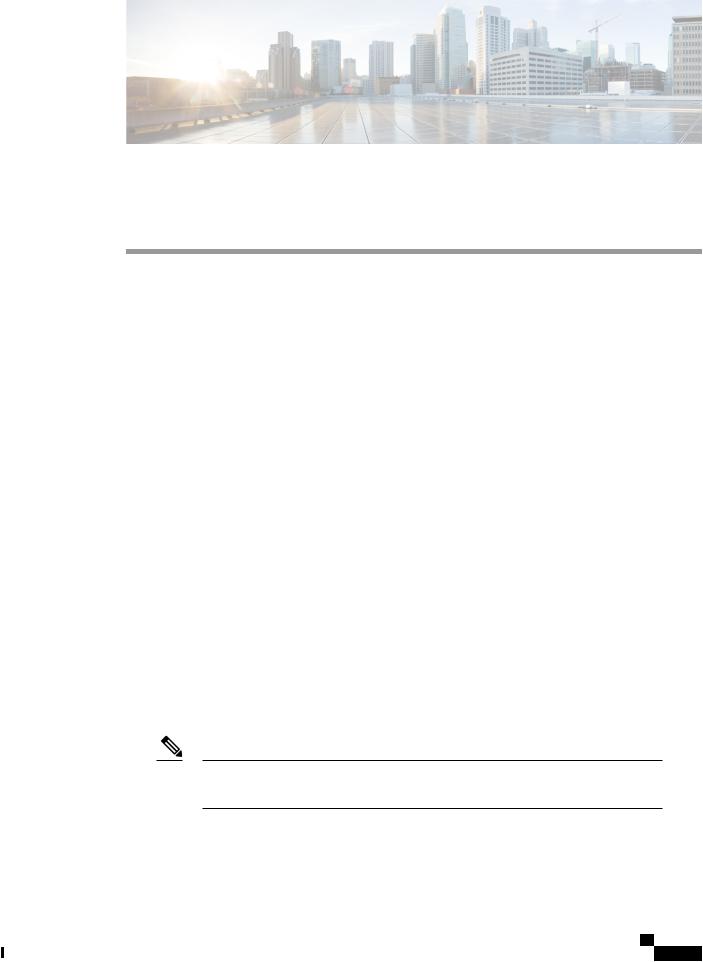
C H A P T E R 1
Overview
• Overview, page 1
Overview
The Cisco Nexus 93108TC-FX switch (N9K-C93108TC-FX) is a 1-RU, fixed-port switch designed for spine-leaf-APICdeploymentindatacenters. Thisswitchhas4810GBASE-TApplicationPolicyInfrastructure Controllers(APICs)facingportsthatsupport100-Megabits,1- or10-GigabitEthernetconnections,andithas six fixed 40/100-Gigabit QSFP28 spine-facing ports. The chassis for this switch includes the following user-replaceable components:
• Fan modules (four) with the following airflow choices:
◦Port-side intake airflow with burgundy coloring (NXA-FAN-30CFM-B)
◦Port-side exhaust airflow with blue coloring (NXA-FAN-30CFM-F)
•Power supply modules (two—one for operations and one for redundancy [1+1]) with the following choices (do not mix AC and DC power sources and do not mix airflow directions):
◦500-WACpowersupplywithport-sideintakeairflow(burgundycoloring)(NXA-PAC-500W-PI)
◦500-W AC power supply with port-side exhaust airflow (blue coloring) (NXA-PAC-500W-PE)
◦930-WDCpowersupplywithport-sideintakeairflow(burgundycoloring)(NXA-PDC-930W-PI)
◦930-W DC power supply with port-side exhaust airflow (blue coloring) (NXA-PDC-930W-PE)
◦1200-W HVAC/HVDC power supply with dual-direction airflow (white coloring) (N9K-PUV-1200W)
Note Ifyouareusingthe1200-WHVAC/HVDCpowersupply,thepowersupplyautomatically uses the same airflow direction as used by the fan modules installed in the same switch.
The following figure shows the hardware features seen from the port side of the chassis.
Cisco Nexus 93108TC-FX ACI Mode Hardware Installation Guide
1
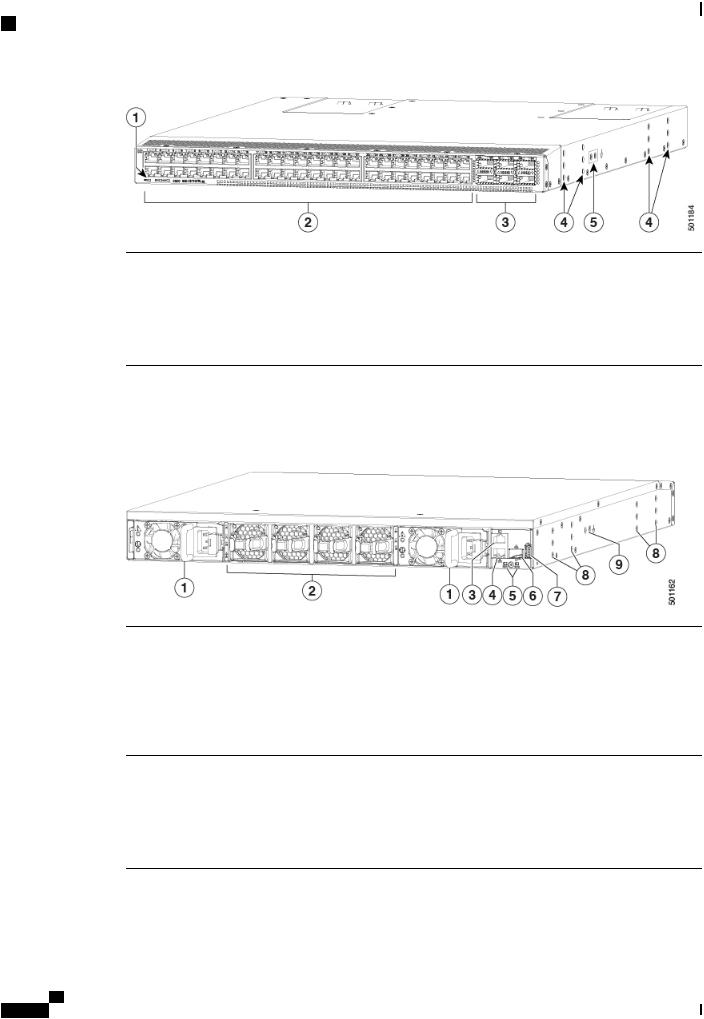
Overview
Overview
1 |
Beacon [BCN], Status [STS], and Environment |
4 |
Screw holes (6) for attaching rack mounting |
|
[ENV] LEDs |
|
brackets |
2 |
48 10/1-Gigabit RJ45 ports |
5 |
Grounding pad |
36 40/100-Gigabit QSFP28 ports
To determine which transceivers, adapters, and cables are supported by this switch, see the Cisco Transceiver Modules Compatibility Information document.
The following figure shows the hardware features seen from the power supply side of the chassis.
1 |
Twopowersupplies(oneusedforoperationsand |
6 |
Management port (SFP+ port) |
|
one used for redundancy) (AC power supplies |
|
|
|
shown) with power supply slot 1 on the left and |
|
|
|
slot 2 on the right |
|
|
2 |
Four fan modules with fan slot 1 on the left and |
7 |
USB port |
|
fan slot 4 on the right |
|
|
3Console port (RS232 port)
8Screw holes (6) for attaching rack mounting brackets
4 Management port (RJ-45 port) |
9 Grounding pad |
5ChassisLEDs(Beacon[BCN]andStatus[STS])
Cisco Nexus 93108TC-FX ACI Mode Hardware Installation Guide
2

Overview
Overview
Note USB support is limited to USB 2.0 devices that use less than 2.5 W (less than 0.5 A inclusive of surge current).Devices,suchasexternalharddrives,thatinstantaneouslydrawmorethan0.5Aarenotsupported.
Depending on whether you plan to position the ports in a hot or cold aisle, you can order the fan and power supply modules with port-side intake or port-side exhaust airflow. To determine the airflow direction of the modules installed in your switch, see the following table.
Replaceable Modules |
Port-Side Intake Airflow Coloring |
Port-Side Exhaust Airflow Coloring |
Fans |
Burgundy |
Blue |
AC power supplies |
Burgundy |
Blue |
HVAC/HVDC power supplies |
White |
|
DC power supplies |
Burgundy |
Blue |
The fan and power supply modules are field replaceable and you can replace one fan module or one power supply module during operations so long as the other modules are installed and operating. If you have only one power supply installed, you can install the replacement power supply in the open slot before removing the original power supply.
Note All of the fan and power supply modules must have the same direction of airflow. Otherwise, the switch can overheat and shut down. If you are installing a dual-direction power supply, that module will automatically use the same airflow direction as the other modules in the switch.
Caution If the switch has port-side intake airflow (burgundy coloring for fan modules), you must locate the ports in the cold aisle. If the switch has port-side exhaust airflow (blue coloring for fan modules), you must locate the ports in the hot aisle. If you locate the air intake in a hot aisle, the switch can overheat and shut down.
Cisco Nexus 93108TC-FX ACI Mode Hardware Installation Guide
3

Overview
Overview
Cisco Nexus 93108TC-FX ACI Mode Hardware Installation Guide
4
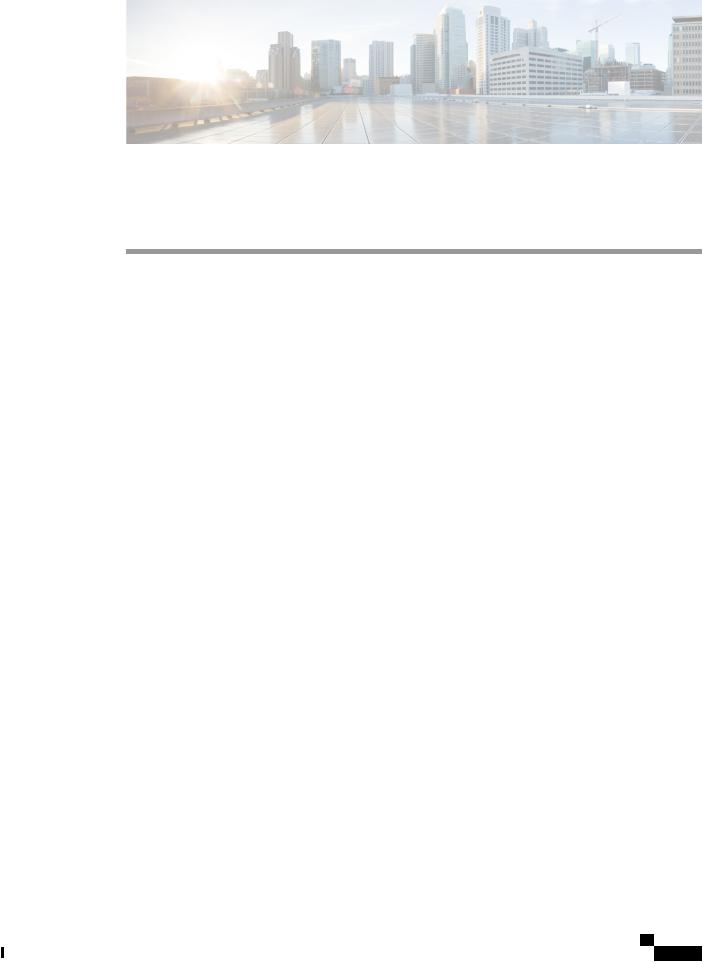
C H A P T E R 2
Preparing the Site
• Temperature Requirements, page 5
• Humidity Requirements, page 5
• Altitude Requirements, page 6
• Dust and Particulate Requirements, page 6
• Minimizing Electromagnetic and Radio Frequency Interference, page 6
• Shock and Vibration Requirements, page 7
• Grounding Requirements, page 7
• Planning for Power Requirements, page 7
• Airflow Requirements, page 9
• Rack and Cabinet Requirements, page 9
• Clearance Requirements, page 10
Temperature Requirements
The switch requires an operating temperature of 32 to 104 degrees Fahrenheit (0 to 40 degrees Celsius). If theswitchisnotoperating,thetemperaturemustbebetween –40to158degreesFahrenheit(–40to70degrees Celsius).
Humidity Requirements
High humidity can cause moisture to enter the switch. Moisture can cause corrosion of internal components and degradation of properties such as electrical resistance, thermal conductivity, physical strength, and size. The switch is rated to withstand from 5- to 95-percent (non-condensing) relative humidity.
Buildings in which the climate is controlled by air-conditioning in the warmer months and by heat during the colder months usually maintain an acceptable level of humidity for the switch equipment. However, if the switch is located in an unusually humid location, you should use a dehumidifier to maintain the humidity within an acceptable range.
Cisco Nexus 93108TC-FX ACI Mode Hardware Installation Guide
5
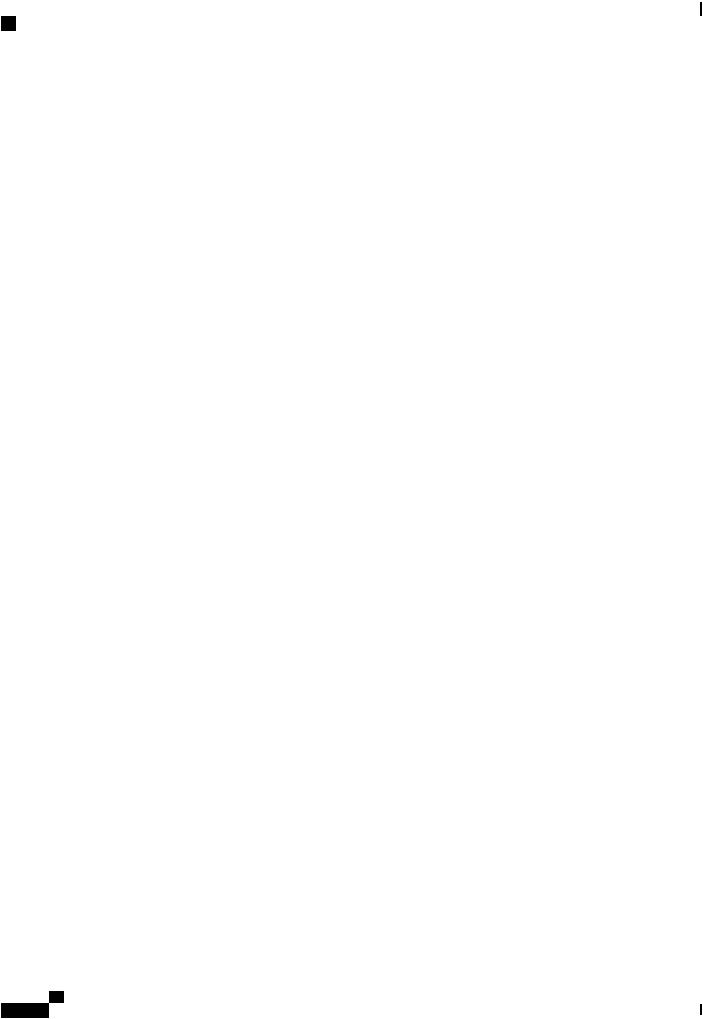
Preparing the Site
Altitude Requirements
Altitude Requirements
The following table lists the maximum altitude that this switch is tested to operate. This switch is rated to operate at altitudes from 0 to 13,123 feet (0 to 4,000 meters). If you operate this switch at a higher altitude (lowpressure),theefficiencyofforcedandconvectioncoolingisreducedandcanresultinelectricalproblems that are related to arcing and corona effects. This condition can also cause sealed components with internal pressure, such as electrolytic capacitors, to fail or to perform at a reduced efficiency.
Dust and Particulate Requirements
Exhaust fans cool power supplies and system fans cool switches by drawing in air and exhausting air out throughvariousopeningsinthechassis. However,fansalsoingestdustandotherparticles,causingcontaminant buildup in the switch and increased internal chassis temperature. A clean operating environment can greatly reducethenegativeeffectsofdustandotherparticles,whichactasinsulatorsandinterferewiththemechanical components in the switch.
In addition to regular cleaning, follow these precautions to avoid contamination of your switch:
•Do not permit smoking near the switch.
•Do not permit food or drink near the switch.
Minimizing Electromagnetic and Radio Frequency Interference
Electromagnetic interference (EMI) and radio frequency interference (RFI) from the switch can adversely affect other devices, such as radio and television (TV) receivers, operating near the switch. Radio frequencies that emanate from the switch can also interfere with cordless and low-power telephones. Conversely, RFI from high-power telephones can cause spurious characters to appear on the switch monitor.
RFIisdefinedasanyEMIwithafrequencyabove10kHz. Thistypeofinterferencecantravelfromtheswitch to other devices through the power cable and power source or through the air as transmitted radio waves. The Federal Communications Commission (FCC) publishes specific regulations to limit the amount of EMI and RFI that can be emitted by computing equipment. Each switch meets these FCC regulations.
To reduce the possibility of EMI and RFI, follow these guidelines:
•Cover all open expansion slots with a blank filler plate.
•Always use shielded cables with metal connector shells for attaching peripherals to the switch.
When wires are run for any significant distance in an electromagnetic field, interference can occur between the field and the signals on the wires with the following implications:
•Bad wiring can result in radio interference emanating from the plant wiring.
•StrongEMI,especiallywhenitiscausedbylightningorradiotransmitters,candestroythesignaldrivers and receivers in the chassis and even create an electrical hazard by conducting power surges through lines into equipment.
Cisco Nexus 93108TC-FX ACI Mode Hardware Installation Guide
6

Preparing the Site
Shock and Vibration Requirements
Note To predict and prevent strong EMI, you might need to consult experts in radio frequency interference (RFI).
The wiring is unlikely to emit radio interference if you use twisted-pair cable with a good distribution of grounding conductors. If you exceed the recommended distances, use a high-quality twisted-pair cable with one ground conductor for each data signal when applicable.
Caution If the wires exceed the recommended distances, or if wires pass between buildings, give special consideration to the effect of a lightning strike in your vicinity. The electromagnetic pulse caused by lightning or other high-energy phenomena can easily couple enough energy into unshielded conductors to destroy electronic switches. You might want to consult experts in electrical surge suppression and shielding if you had similar problems in the past.
Shock and Vibration Requirements
The switch has been shockand vibration-tested for operating ranges, handling, and earthquake standards.
Grounding Requirements
The switch is sensitive to variations in voltage supplied by the power sources. Overvoltage, undervoltage, and transients (or spikes) can erase data from memory or cause components to fail. To protect against these typesofproblems,ensurethatthereisanearth-groundconnectionfortheswitch.Youcanconnectthegrounding pad on the switch either directly to the earth-ground connection or to a fully bonded and grounded rack.
Whenyouproperlyinstallthechassisinagroundedrack,theswitchisgroundedbecauseithasametal-to-metal connection to the rack. Alternatively, you can ground the chassis by using a customer-supplied grounding cable that meets your local and national installation requirements (we recommend 6-AWG wire for U.S. installations) connected to the chassis with a grounding lug (provided in the switch accessory kit) and to the facility ground.
Note You automatically ground AC power supplies when you connect them to AC power sources. For DC powersupplies,youmustconnectagroundingwirewhenwiringthepowersupplytotheDCpowersource.
Planning for Power Requirements
The switch includes two power supplies (1-to-1 redundancy with current sharing) in one of the following combinations:
•Two 500-W AC power supplies
•Two 1200-W HVAC/HVDC power supplies
•Two 930-W DC power supplies
Cisco Nexus 93108TC-FX ACI Mode Hardware Installation Guide
7

Preparing the Site
Planning for Power Requirements
Note Both power supplies must be the same type. Do not mix AC, DC, and HVAC/HVDC power supplies in the same chassis.
Note Forn+1redundancy,youcanuseoneortwopowersourcesforthetwopowersupplies.Forn+n redundancy, you must use two power sources and connect each power supply to a separate power source.
Note Some of the power supply modules have Underwriter Labs (UL) rating capabilities that exceed the switch requirements. Whencalculatingpowerrequirements,usetheswitchrequirementstodeterminetheamount of power required for the power supplies.
To minimize the possibility of circuit failure, make sure that each power-source circuit used by the switch is dedicated to the switch.
Note For AC input application, please refer to the statement below:
Warning Statement 1005—Circuit Breaker
This product relies on the building's installation for short-circuit (overcurrent) protection. Ensure that the protective devices are rated not greater than 20A (North America), 16A (Europe), and 13A (UK).
Note For DC input application, please refer to the statement below:
Warning Statement 1005—Circuit Breaker
This product relies on the building's installation for short-circuit (overcurrent) protection.
•Ensure that the protective devices are rated not greater than 40A when the switch is powered with regular DC power supplies (rated 48-60VDC).
•Ensure that the protective devices are rated not greater than 10A when the switch is powered with HVDC power supplies (rated 240-350VDC).
Note For the power cables to use with the power supplies, see Power Cable Specifications, on page 49.
Cisco Nexus 93108TC-FX ACI Mode Hardware Installation Guide
8

Preparing the Site
Airflow Requirements
Airflow Requirements
The switch is designed to be positioned with its ports in either the front or the rear of the rack depending on your cabling and maintenance requirements. Depending on which side of the switch faces the cold aisle, you must have fan and power supply modules that move the coolant air from the cold aisle to the hot aisle in one of the following ways:
•Port-side exhaust airflow—Coolant air enters the chassis through the fan and power supply modules in the cold aisle and exhausts through the port end of the chassis in the hot aisle.
•Port-sideintakeairflow—Coolantairentersthechassisthroughtheportendinthecoldaisleandexhausts through the fan and power supply modules in the hot aisle.
•Dual-direction airflow—Airflow direction is determined by the airflow direction of the installed fan modules.
You can identify the airflow direction of each fan and power supply module by its coloring as follows:
•Blue coloring indicates port-side exhaust airflow.
•Burgundy coloring indicates port-side intake airflow.
•White coloring on HVAC/HVDC power supplies indicates dual-direction airflow.
Note To prevent the switch from overheating and shutting down, you must position the air intake for the switch in a cold aisle, and all of the fan and power supply modules must have the same direction of airflow (even if their coloring is different). If you must change the airflow direction for the switch, you must shutdown the switch before changing the modules.
Rack and Cabinet Requirements
You can install the following types of racks or cabinets for your switch:
•Standard perforated cabinets
•Solid-walled cabinets with a roof fan tray (bottom-to-top cooling)
•Standard open four-post Telco racks
Work with your cabinet vendors to determine which of their cabinets meet the following requirements or see the Cisco Technical Assistance Center (TAC) for recommendations:
•Use a standard 19-inch (48.3-cm), four-post Electronic Industries Alliance (EIA) cabinet or rack with mountingrailsthatconformtoEnglishuniversalholespacingpersection1oftheANSI/EIA-310-D-1992 standard.
•The depth of a four-post rack must be 24 to 32 inches (61.0 to 81.3 cm) between the front and rear mounting rails (for proper mounting of the bottom-support brackets or other mounting hardware).
•Required clearances between the chassis and the edges of its rack or the interior of its cabinet are as follows:
Cisco Nexus 93108TC-FX ACI Mode Hardware Installation Guide
9
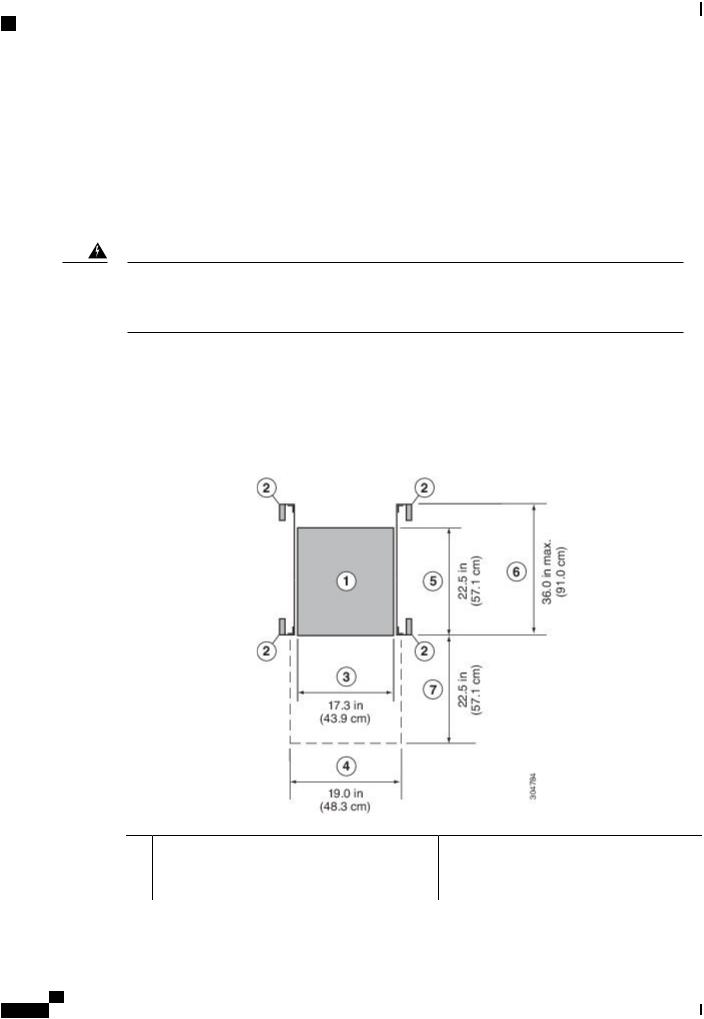
Preparing the Site
Clearance Requirements
◦4.5 inches (11.4 cm) between the front of the chassis and the interior of the cabinet (required for cabling).
◦3.0 inches (7.6 cm) between the rear of the chassis and the interior of the cabinet (required for airflow in the cabinet if used).
◦No clearance is required between the chassis and the sides of the rack or cabinet (no side airflow).
Additionally, you must have power receptacles located within reach of the power cords used with the switch.
Warning Statement 1048—Rack Stabilization
Stability hazard. The rack stabilizing mechanism must be in place, or the rack must be bolted to the floor before you slide the unit out for servicing. Failure to stabilize the rack can cause the rack to tip over.
Clearance Requirements
You must provide the chassis with adequate clearance between the chassis and any other rack, device, or structure so that you can properly install the chassis, route cables, provide airflow, and maintain the switch. For the clearances required for an installation of this chassis in a four-post rack, see the following figure.
1 |
Chassis |
5 |
Depth of the chassis |
2 |
Vertical rack-mount posts and rails |
6 |
Maximum extension of the bottom-support rails |
Cisco Nexus 93108TC-FX ACI Mode Hardware Installation Guide
10
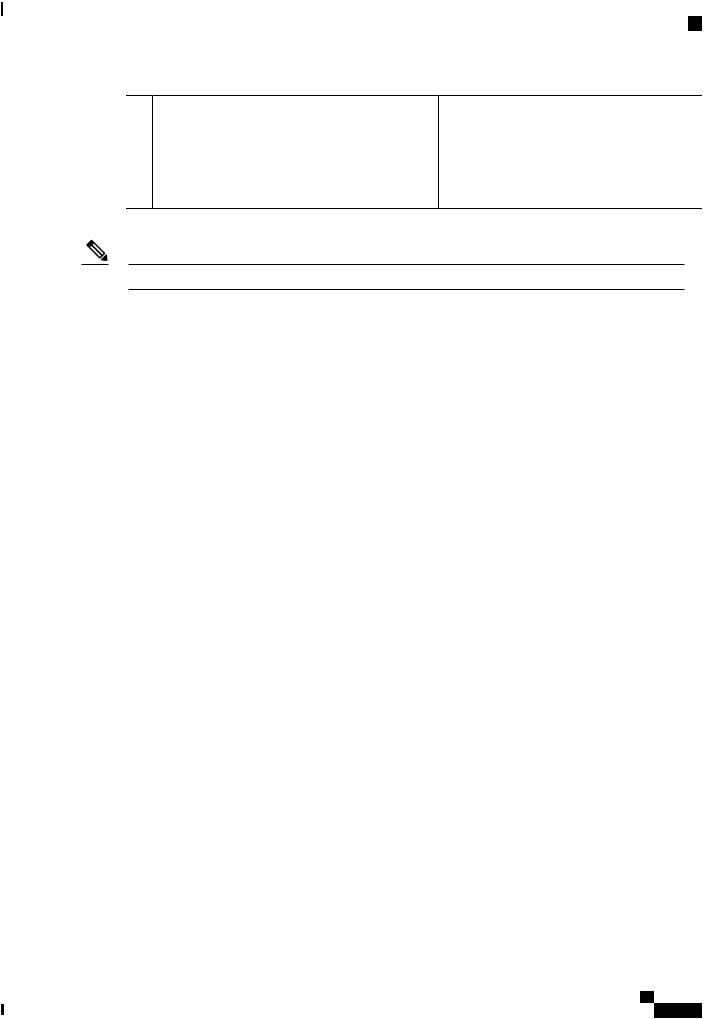
Preparing the Site
Clearance Requirements
3 |
Chassis width |
7 |
Depthofthefrontclearancearea(thisequalsthe |
|
|
|
depth of the chassis) |
4Width of the front clearance area (this equals the width of the chassis with two rack-mount brackets attached to it)
Note Both the front and rear of the chassis must be open to both aisles for airflow.
Cisco Nexus 93108TC-FX ACI Mode Hardware Installation Guide
11
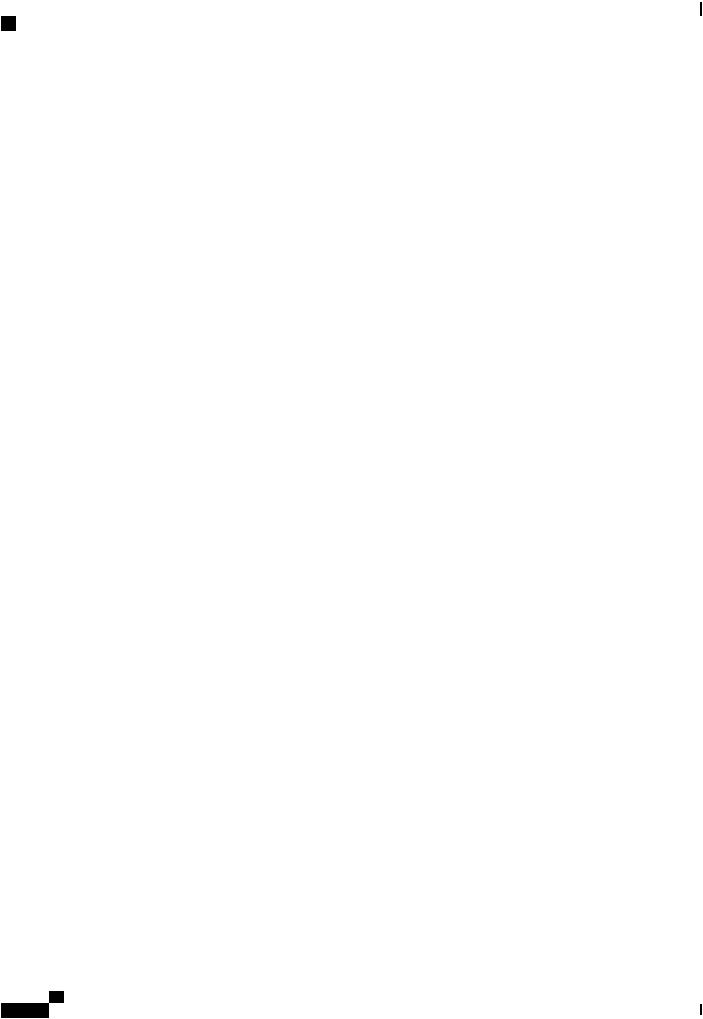
Preparing the Site
Clearance Requirements
Cisco Nexus 93108TC-FX ACI Mode Hardware Installation Guide
12
